The Most In-Depth Dad Blogging Guide Online (Screenshots, Examples, & More)

Welcome to Adam Enfroy’s mega guide on how to start a dad blog.
This dad blogging guide will teach you everything you need to know about starting your own dad blog from scratch even if you’ve never written a word online before.
It contains in-depth instruction on everything it takes to start earning $5,000 – $10,000 per month from blogging. Including:
- How to find a niche and research the competition
- How to do keyword research to find low-competition, high-traffic keywords
- How to choose a name and set up your website
- How to write content that readers love
- SEO basics, so you can grow your dad website traffic
- How to monetize your dad blog and earn passive income from anywhere in the world
Ready to start your dad blog?
Let’s get to it.
Who Are We And Why Should You Listen to Us About Dad Blogs?
Good question.
The reason you should listen to us is simple: we actually do this for a living.
We’ve taught thousands of people how to start, grow, and monetize their own blogs. We’ve made all the mistakes, done all the experimenting, and mastered everything there is to know about blogging – that way, you don’t have to.
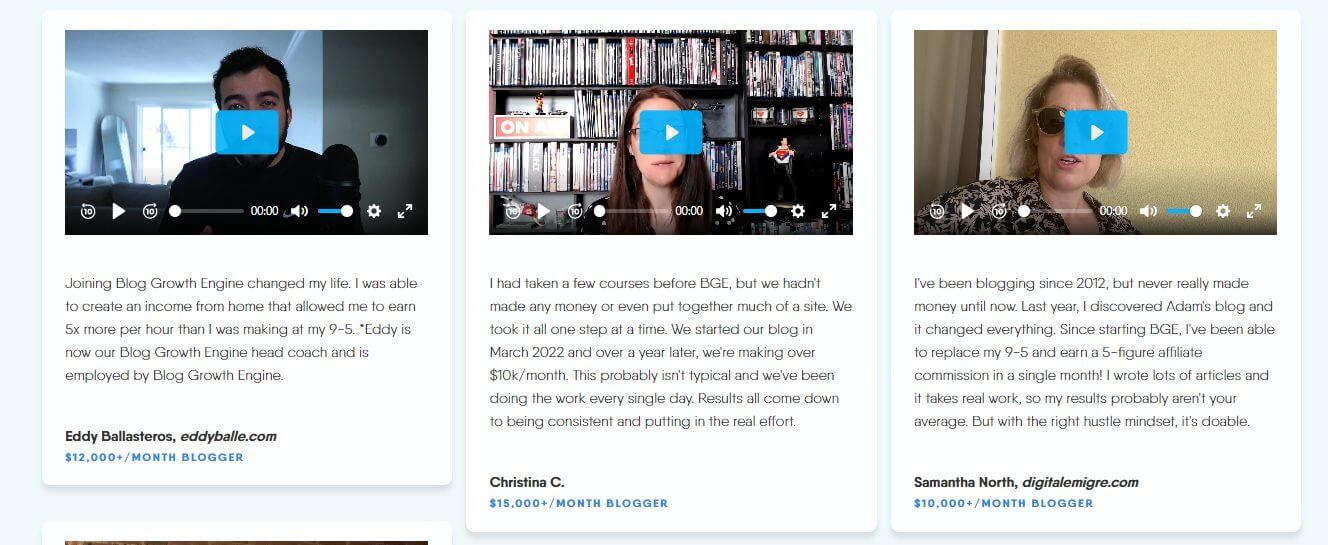
This dad blog guide will teach you the exact same information we teach in our own community.
Look…
Here’s the truth.
There’s been a huge spike in interest for dad bloggers. If you’ve got an idea for a great dad blog, you can make a full-time income and much more. Check out Google trends:

The industry is trending upwards. Mom blogs can make hundreds of thousands of dollars per year. And there are just as many dads as moms (more or less…we don’t work for the Census Bureau, though).
Most dad bloggers make anywhere from $2,000 – $5,000 per month. But the absolute best dad bloggers can make $10,000, $20,000 or more.
Not bad for writing about parenting tips from home.
If I were you, I’d read this article in full and get to work. There’s never been a better time than now.
How to Start a Dad Blog in 5 Steps
Here’s a quick overview of how to become a dad blogger in 5 steps. Read it first to get a basic idea of the process before learning the nitty gritty details. There’s a lot of advice in here on becoming a dad blogger.

How to Become a Dad Blogger Overview
- Niche Down: Find the area of dad life that screams you. You need to find your dad blogger niche like mental health, cooking, dating, or whatever it is you’re all about. You don’t want to be a general dad blogger.
- Find Low-Competition Topics: New blogs won’t rank in Google for competitive topics. You need to find the low-hanging fruit first. Once you start ranking, it’s way easier to rank for the money-making topics. This is the #1 reason why new blogs fail – they don’t write the right blog topics.
- Name Your Blog: Way more important than you think. We’ll show you how to choose a great blog name that’s memorable, brandable, and flexible.
- Set up Your Website: Don’t panic. This is so cheap and easy that anyone can do it.
- Create Awesome Content: We’ll show you exactly how to write high-quality content that your readers love. This is how you sell products, build a following, and grow your brand.
Niche Down Into a Sub-Niche
This is the single most important lesson in all of blogging. Period.
It’s the first thing we teach all of our new students at BGE.
You must find a sub-niche within your niche to focus on first. If not, you’ll have no chance of competing.
Here’s a good example of a niche dad blogger:

LunchBox Dad writes about cheap food recipes. This is his thing. He’s not just writing whatever comes to his mind like dad jokes, family life, parenting tips, or what’s on TV. He focuses on one specific thing.
Why is he doing this?
Because you can’t just jump right in and start writing about general dad topics.
If you do, you’ll be up against the best dad blogs with more content. That would be like starting a small supermarket and trying to go up against Wal-Mart from day 1.
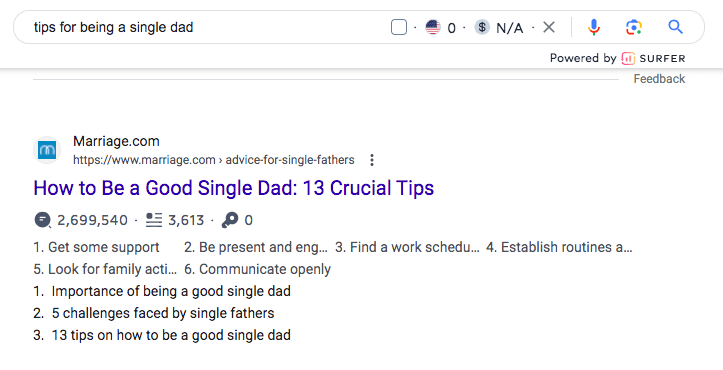
There’s no way you’re going to rank above Marriage.com as a new blog. You’ve got to build up some authority with Google first. Don’t worry, much more on that later.
Back to niching down…
Niching down into a narrower topic allows you to create focused content for your audience, stand out from the masses, and gain authority with Google.
What we’re trying to say is that you don’t just want to write about general fatherhood. Instead, you need to find your own little corner of fatherhood to write about. THEN, expand from there.
Sub-niches include things like:
- Dad fitness
- Single dad life
- Single dad dating
- Christian dad life
- Stay-at-home dads
Why You Need a Sub-Niche Within Fatherhood For Your Dad Blog
The reason is that Google prefers sites with a narrow focus, especially if you’re a new site.
Google heavily favors websites with something called topical authority.
Topical authority is basically how relevant your site is to a certain topic. A simple way to think about it is topical authority is basically how many blog posts on one particular topic you have.
The more the better.
If you write dozens of informative parenting articles, Google sees you as an expert in that topic.
So, it’ll rank you for more keywords in that niche. Having a sub-niche makes it easier for you to obtain topical relevance quickly. “Dad blog” could have thousands of sub-topics to cover, but “dad fitness blog” or “dad mental health” might have only a few dozen.
See the benefit now?
|
Note: Don’t worry, it’s fairly easy to gain more authority. There’s an exponential “roll-over” effect when you start ranking for keywords in your niche. If you rank for easy terms like “tips for fighting dad bod”, that can add to your authority. Now, with more authority, you can rank for more difficult – and lucrative – keywords. Just start small and go for low-hanging fruit. |
|---|
How to Find And Validate Your Dad Blog Topic
The ideal dad blog sub-niche lies at the intersection of you, your expertise, your experience, and market.
Long story short, you want something that:
- You’re good at
- Care about
- Can actually make you money
This is a concept we call the Authority Flywheel:

You have to answer these questions:
- You: Who are you and what do you want? What’s your story? Which unique experiences do you have? What are your successes and failures?
- Expertise: What are you good at? What skills do you have? Cooking, fitness, DIY? Do you have any certifications? Accounting, personal trainer, programming?
- Market: Is it profitable? Can you compete? Is there demand? Dad blogs are taking off, but is your particular sub-niche viable?
- Leverage: What else can you leverage? Your personal network? Friends and family? Job contacts? Previous employers? It all matters.
We don’t have time to get into every minor little detail of your flywheel.
But we CAN do this…
Once you find your sub-niche at the center of your flywheel, you can explore the market this way…
Write down at least 5 unique topics you can write about, and start validating the market. Let’s jump to that now..
How to Validate Your Sub-Niche Idea
It’s best to do some research on your niche just to make sure it’s not too competitive.
If your sub-niche is full of giant “high-authority” sites, it’s going to be a tough battle.
Remember, your goal is to rank not just on the first page, but in the top 3-5 results. If that real estate is occupied by massive sites, you might have to abandon ship.
Take your topics and plug them into Google and see what pops up.
Let’s stick with the dad fitness example:
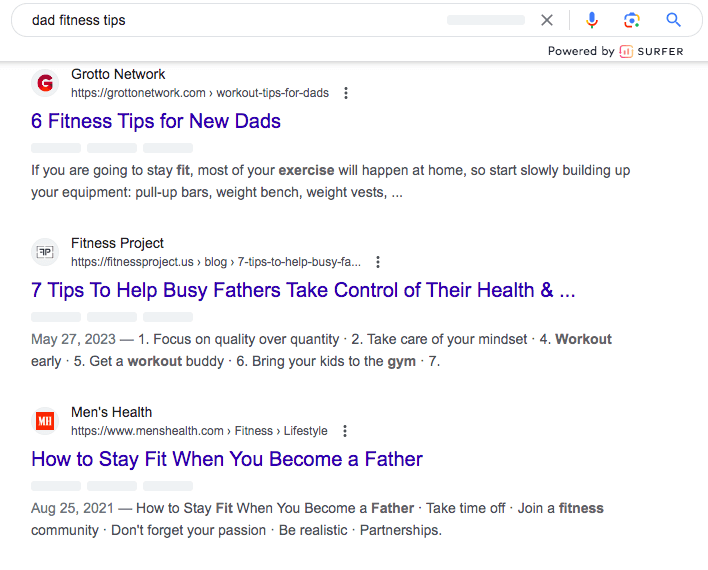
Not too bad. Men’s Health is a BEAST, but the other two don’t look so tough.
In general, stay away from topics with lots of “media sites” in the results. Media sites are kind of like online magazines or newspapers. Forbes, Men’s Health, and The New York Times are a few examples.
Stick to topics where you see mostly other dad bloggers.
Let’s try just dad fitness and see what we get:
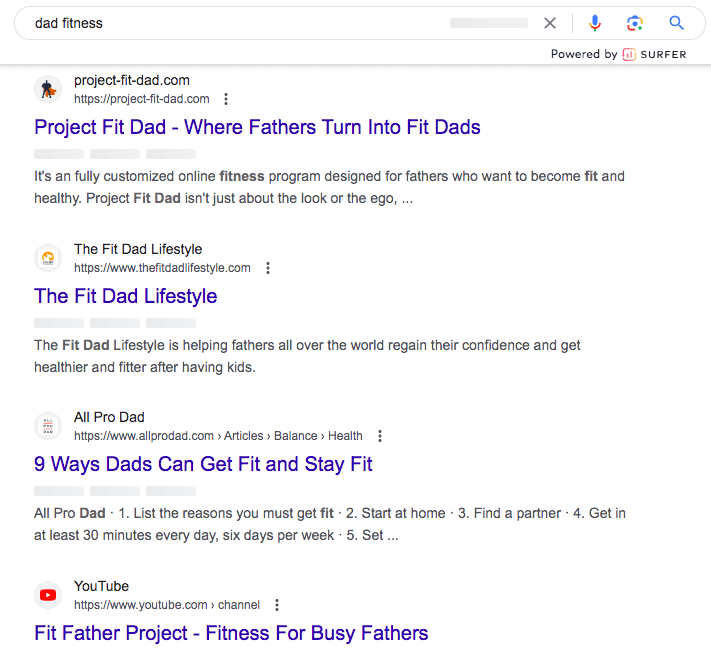
No media sites here. Just regular dad bloggers.
And there’s even a YouTube video (that’s a great sign). It should be easy to outrank a YouTube video with a website.
Let’s try another example – single dads.
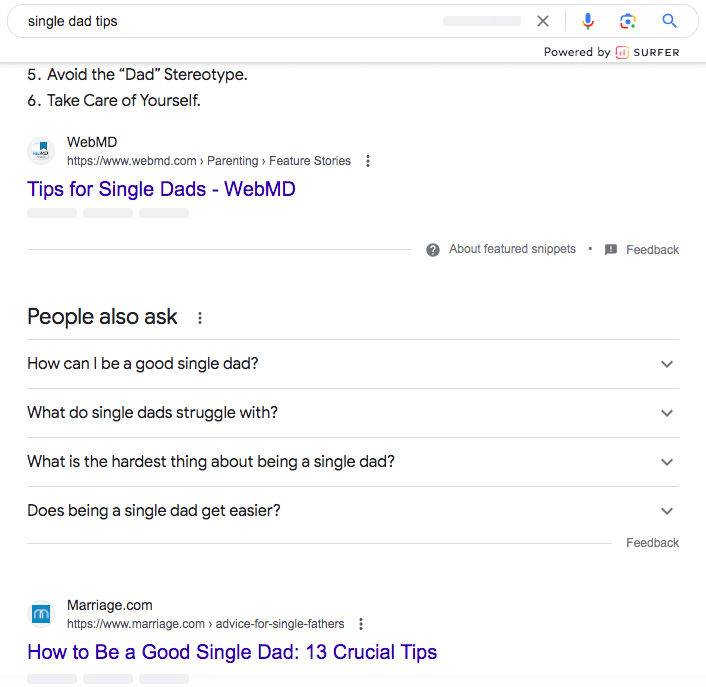
Not good. WebMD is basically the Death Star. And Marriage.com isn’t much easier to beat either.
If we “niche down” a bit further into something like “single dad dating”, we might get a different picture.
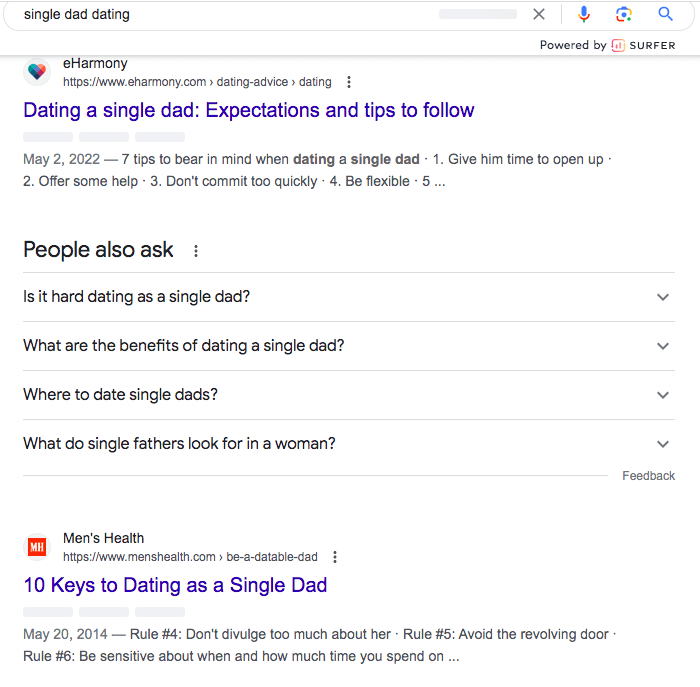
Not much better, sadly. eHarmony and Men’s Health. No normal dad bloggers here.
It’s important to do this for all of your blog topic ideas. You’d be surprised at all the golden nuggets you could find. For example, let’s stick with the dating niche.
I went even further into the niche and looked for “single dad dating advice”. The result wasn’t too good:
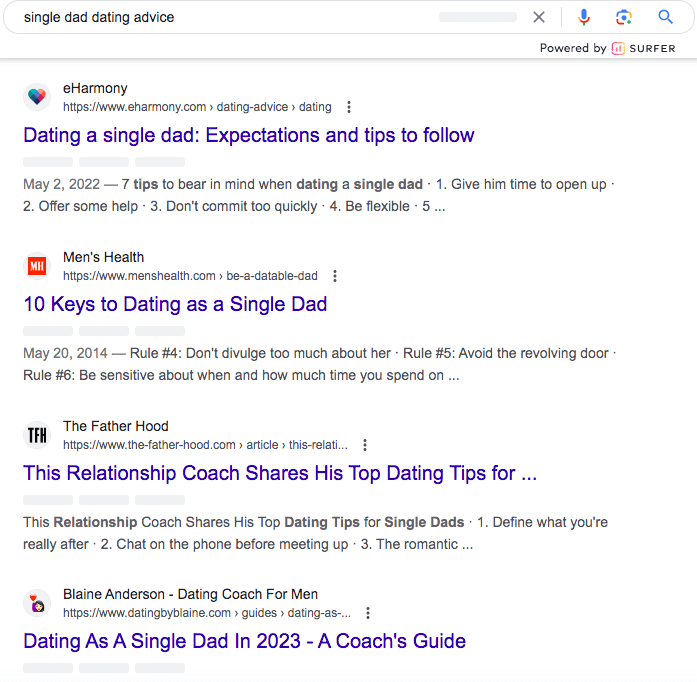
4 pretty strong results on the first page.
If all of your topics have strong sites ranking in the top spots, it’s a bad sign.

Dad Blog Niche Examples
The majority of dad blogs were on the following topics:
- Being a new dad
- Being a stay at home dad
- Being a single dad (Days of a Domestic Dad is great, by the way)
- Being a geek dad
- Being a gay dad
- Raising kids in the age of social media
- Life as a dad influencer on social media
- Raising a child with down syndrome
- Stay at home dads raising older kids
- Raising children after loss (Just a Dad is a must read)
Most of these fatherhood blogs are pretty straightforward: family life, parenting advice, daddy style diaries, etc. But you could blog about anything you want so long as there’s demand. For example, Daddy Poppins only does dad humor…and he’s great at it:

Remember, you can always expand to new topics as a dad blogger (more on that in a bit).
2. Perform Keyword Research to Find Low Competition Topics
Now is where the fun begins.
Finding your niche is the most important step in your dad blogger journey. Keyword research is the most fun step.
You’re going to find so many new and exciting opportunities.
Quick Note: There are more or less two types of post in the SEO world: informational and transactional. Informational articles inform people (duh). An example could be “5 tips for raising kids as a single dad”. Transactional posts sell stuff. Think “5 Christmas gifts for dads”. This will be important moving forward.
The Goal of Keyword Research
Your goal from the outset is to find low-competition keywords that you could rank for relatively easily as a new dad blog. As you research, start creating a content plan. Think of it like plotting a course that steers your ship in the right direction.
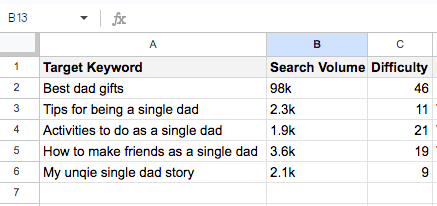
A basic plan looks something like this.
Remember, older blogs with more content will have a big advantage over you. So, you need to develop a killer mindset and attack them where they’re weak. Once you build up some authority of your own with easier topics, you can take your shot at the big boys.
Just start with a simple plan at the beginning like this:
- 3 informational posts
- 2 transactional posts
- 1 unique post (this is something unique to you like your life story or a topic you are passionate about)
This is only to get the ball rolling.
The hardest part of this journey is taking the first step. We see so many students try too hard to make a yearly content plan, then freeze. Getting a few posts up and seeing results is so invigorating. Once you taste success, you’ll be addicted.
Ready to hunt some low-hanging fruit? Let’s do it.
How to do Keyword Research The Right Way
One more thing. So many SEOs overcomplicate this just to make money or create more content. All those “hacks” and “secrets” are gimmicks. It’s actually a lot easier than you might think.
You’re going to need a tool like Ahrefs or SEMRush. You can’t do this without them.

They eliminate hundreds of hours of work and all of the guessing games. You could do a month’s worth of research in just hours…AND you’ll actually get accurate data. Without them, you’ll just be taking shots in the dark.
Ahrefs isn’t cheap, but if you aren’t willing to invest in your business, then just quit now.
Where were we?
Oh, yeah. How to do keyword research for your dad blog.
Start With Seed Keywords
Seed keywords are broad terms related to your niche. You won’t be writing about these topics yet. They will just help you find other topics you can write about.
For dad blogs, seed keywords might be:
- Dad tips
- Dad gifts
- How to be a good parent
It depends on which sub-niche you want to start with.
If you want to start with dad fitness, a seed keyword would be just dad fitness or dad workout. If it’s parenting, it could be dad parenting or just dad tips. It all depends.
Take these, and let’s plug them into Ahrefs.
Finding Low-Competition Topics Using Ahrefs
If you’re nerdy in any way, you’re going to love this part of the tutorial.
Head over to Ahrefs and plant your seeds. This tool is like black magic for SEO. It’s going to show you tons of lucrative keyword opportunities for blog topics.
Let’s try a seed keyword like dad tips:

Check out all of that data. This shows you literally everything you need to know to find low-hanging fruit. This is how you’re going to start getting traffic to your dad blog.
Keyword difficulty of 19 is excellent. That means it won’t be so hard to rank.
Next, click on “matching terms” on the left hand side, and see what the black magic engine tells you.
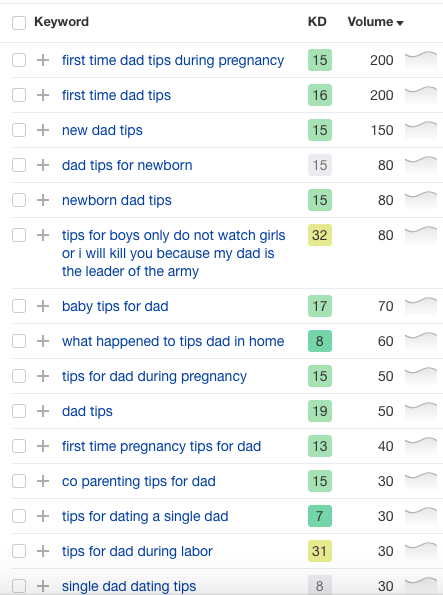
First off, we have 0 clue what’s going on with that one in the middle. “Tips for boys only do not watch….”. That’s a bit strange. Just ignore it!
The column to the right of the topics is keyword difficulty (KD). Green means good. In the beginning, you don’t want to go over a KD of 15-20.
NOTE: Even if a topic doesn’t have much volume or any chance to make you money, you should still write it. Remember, you have to build credibility in Google’s eyes. The more posts you publish on a certain topic, the more authority you gain. It’s a massive snowball effect. Publish easy topics, rank, gain authority, and grow. Lather, rinse, repeat.
Let’s click on the topics and explore more:
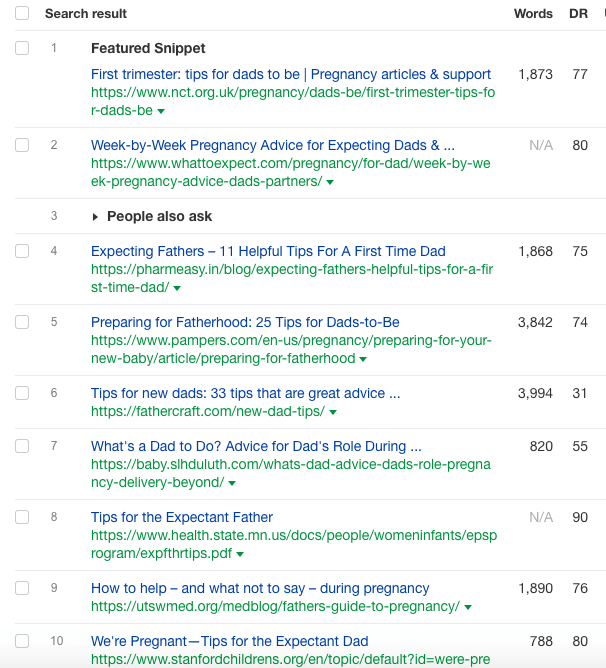
If you scroll down, you’ll see data from the Google search results page (SERP). This shows you how strong your competition is.
This is actually a competitive topic. A lot of the results are high domain rating (DR) sites. That means they are pretty strong. However, there is one DR 31, so there’s some room on the SERP to fight your way in.
Probably better to leave this topic for later once you’ve got some authority of your own.
However, if we look at something like “new dad tips”, it’s a bit easier.
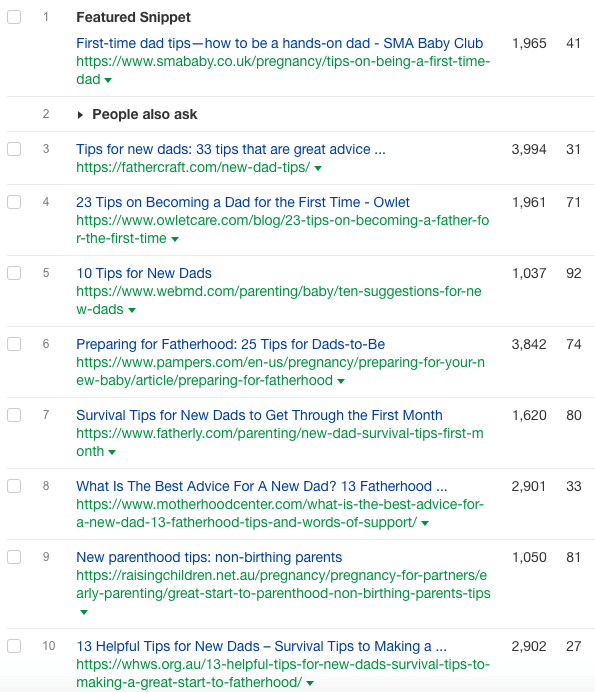
There are few “low-DR” sites in the top 10. This will be easier to “scale the walls and take the castle”.

Here’s an example that’s clearly a “link bait” post:

If you create lots of these assets, you’ll be a link-getting machine. This is where so many new bloggers screw things up. They create content no one wants to link to. Very few bloggers are doing this. This will be a major competitive advantage for you.
Back to Keyword Research…
Repeat this process until you’ve found enough low-competition topics, and get to cranking out content.
You can save your dad blog topics in Ahrefs under “Add To” in the top right corner:

Now that you’ve got your starter plan, let’s get your blog set up. It’s a lot easier than you think it is.
3. Name Your Blog And Choose a Domain Name
A domain name is just your blog’s address online. AdamEnfroy.com is our domain name. We’ll talk more about that in a second, though. Let’s start with naming your dad blog.

Your dad blog’s name is 10 times more important than you think it is.
Here’s why…
If you go too narrow, you’ll pigeon hole yourself into one small corner. That’s going to make it really hard to expand. This is one of the biggest mistakes our new students make.
For example, DadBodTips.com might sound like a cool dad fitness blog name. But if you ever want to write about other topics, it’ll be difficult.
Remember, you don’t want to build a super-niche site. You’re just starting out in a small niche and expanding later.
The goal is to build a large site, brand, and maybe even other assets down the road like a YouTube channel or course. It’s so important that we even dedicate an entire video to explaining this in the course (in more detail than we can here).
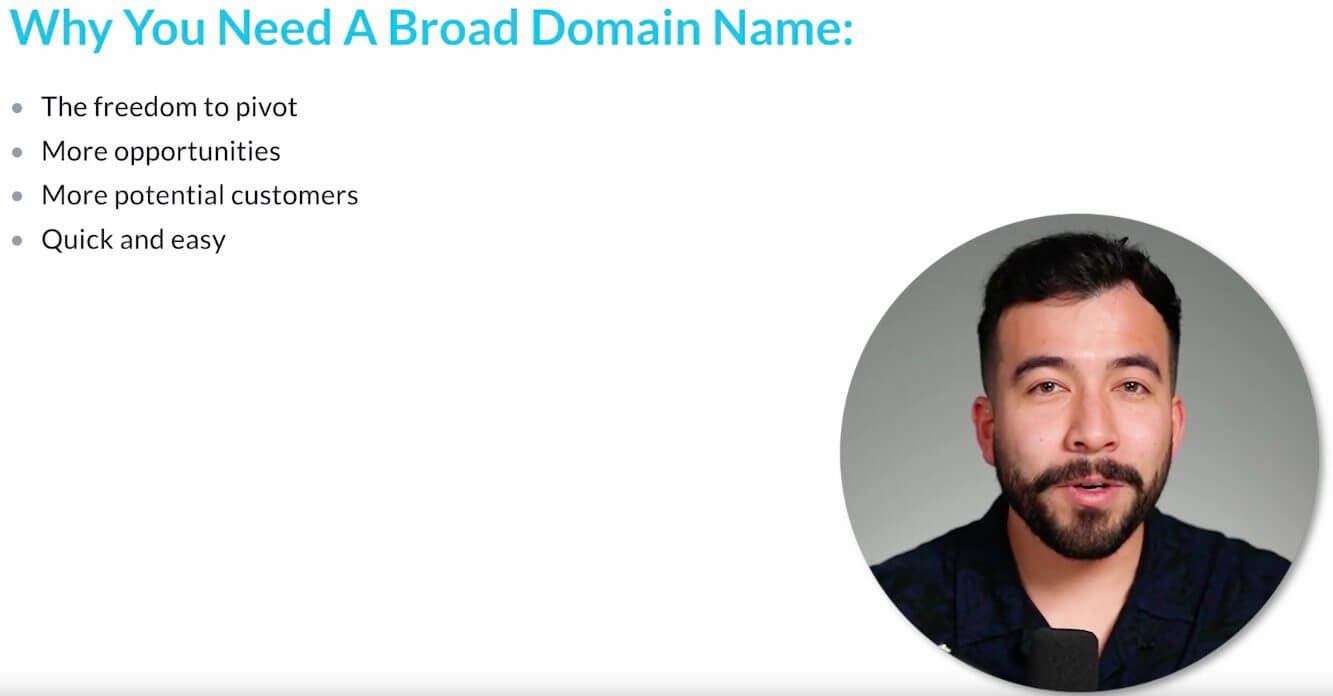
Basically, you want a name that’s broad enough so that you can expand or even pivot down the road.
In general, you want your blog name to be:
- Broad: General enough to expand like we said before.
- Simple: Your name needs to be super simple and memorable. Keep it to 2-3 words maximum. So, StevesDadDIYEmporium.com is out. StevesDadBlog is a lot better.
- Brandable: You want a name that’s easy to brand. That’s why we always recommend using just your name. Here’s a good example – AdamEnfroy.com (wink wink).
Here are some tips for coming up with a great name for your dad blog:
- Use Dad or Synonyms: This is why they pay us the big bucks. Super obvious tips like “use dad in your blog name”. It’s almost comical, but it needs to be said. Dad, father, pop, grandpa – pretty much all the big dad blogs use these words. Fatherly, the Father Hood, Lunch Box Dad, The Dad Website – noticing a pattern?
- Add Your Expertise to Your Domain Name: I love “The Running Mom”. Steal this idea for your dad blog. The Cooking Dad, The Running Dad, The Designer Dad, Geek Dad, The (Insert Whatever You Do) Dad.
- Use a Free Name Generator: When all else fails, plug a few ideas into a free name generator and see what pops up. You never know what gold you might find buried in those hills.
Buying a Domain Name And Web Hosting
Your site’s domain name is just the name that users type into their browser to get to your site. And web hosting is just a service that keeps your site running.
Think of your domain like your home address and web hosting as the power company that keeps your lights on.
You 100% need both of these things or else you can’t run your website. Don’t worry, they are both super affordable.
Here’s an example:

It’s $10 for a simple domain name.
And hosting starts at around $1.50 a month (way cheaper than my electric bill).
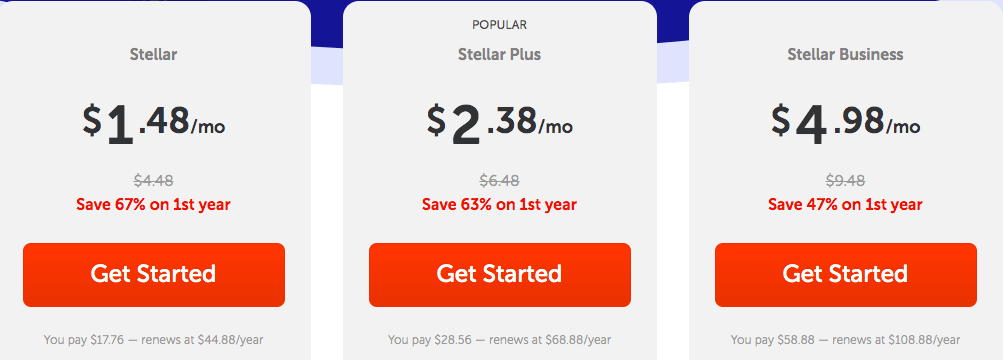
We recommend NameCheap or BlueHost. Both are affordable, fast, and super convenient. It’s way easier to have both your web host and domain with the same company.
Further Read: Check out our 27 best web hosting services if you’re unsure about NameCheap or BlueHost. You might find a better fit.
4. Choose a Blogging Platform
Starting a blog in 2023 is so much easier than it used to be. Before, you needed a custom website.
Nowadays, all you need is a blogging platform like WordPress.

A blog platform is a software that’s specifically designed to host blogs. You’ll get a website, digital marketing features, blog designs, and one-click blog post publishing. It’ll look like a custom website, but it’ll be a WordPress site.
WordPress is gives you blogging super powers like:
- Simple post publishing
- Simple content creation
- Pre-designed website themes that look like professional websites
- Plugins to extend functionality for marketing, search engine optimization, and social media visibility
We DO NOT recommend free blogging platforms like Wix or Squarespace. They’re basically a straightjacket for your website. There’s so little you can do. And once you use their platform, there’s no way out.

Medium is another popular “free platform”. Stay away. It’s super unprofessional and is very limited. There’s a reason it’s free.
WordPress powers nearly half the internet for one simple reason: it’s hands down the best blogging platform.
Beginner bloggers love it because you barely need to do any design work. Just choose one of the best WordPress themes and you’re set.
WordPress themes are pre-designed layouts for your website. Think of them as starter kits where most of the work is done for you. You’ll get key pages, designs, colors, and branding all right out of the box.
There are even templates for dad blogs.
Check out Astra, Divi, or Seedprod. It’s easy to build a family website on any of the 3.
If you can’t decide, just go with Astra. It’s the most popular theme…and it doesn’t hesitate to let you know that.

From there, just install the theme, add your content, and you’re good to go.
Pro Tip – Please, do not use a free theme. It’s not worth it. Your site will be too slow, and you’ll have very few options to customize.
Start Writing Your Blog Posts

The time has come.
You’ve got your content battle plan and your site up and running. Now it’s time to attack.
Before we get to writing, there’s one thing we need to get out of the way:
Writing quality content is crucial for SEO.
Quality content is how you grow an audience, grow a brand, and sell products.
If you put effort into writing quality, you’ll reap all the benefits:
- Readers will spend more time on your website
- People will trust you more and buy from you
- People will share your content with others
- They’ll sign up for your email list
In fact, it goes even deeper than this.
If you write low-quality content, you might even get penalized.
That means Google might throw you in Google jail and not let you rank any articles.
Sometimes it’s a life sentence. Check out this Google article on manual penalties to see the consequences of getting one…not fun.
Trust us, we’ve seen the data. Great content converts better and future proofs your website. It’ll lead to better, more stable long-term rankings. Put in the effort now, and you’ll win in the long run.
Here’s some proof just to drive the point home:
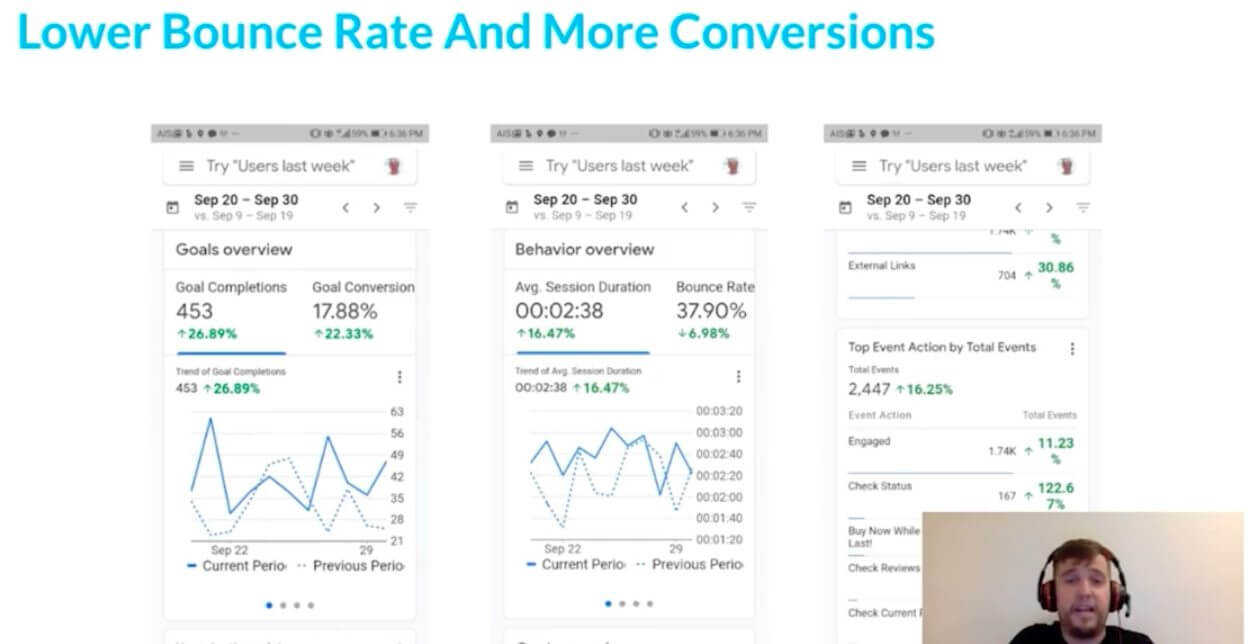
We won’t go into all of the details. But that’s a lot of green and a lot of plus marks.
Average session duration (the amount of time people spend on your site) increased by 16.47%. And goal completions increased by 22.33%.
As they say in the NBA: ball don’t lie. The numbers show that writing good content works. Imagine 22% more clicks or sales on all of your articles. That’s the power of great content.
How to Write High-Quality Content That Converts
If you want to be one of the best dad blogs, follow these principles:
Write in a Conversational Tone
The best dad blogs have content that sounds like a regular dad talking about dad life.
In general, you want to write like you speak. If you wouldn’t say it like that, then don’t write it that way.
Most blogs sound like corporations or academics. This is NOT how you connect with an audience.
Here’s an example:
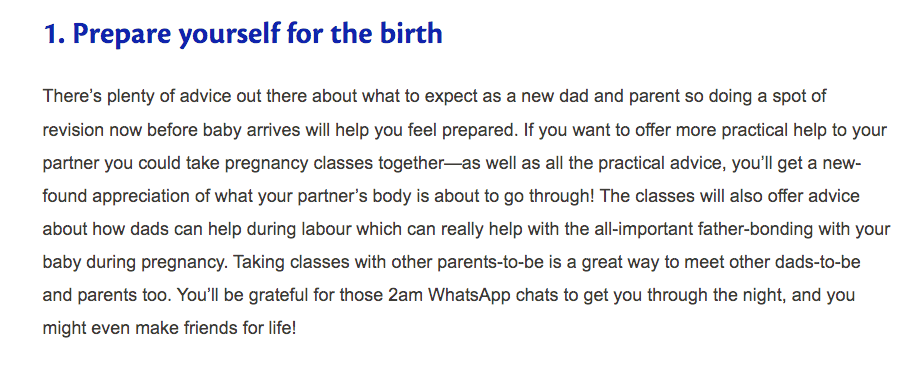
This is from an article on dad tips for newborns. Does it sound like a real “average dad” or does it sound like every other blog out there? It’s the latter.
Most dad bloggers write like this. Don’t be like them.
You need to have a unique voice. Write like you. Think of speaking to another dad about dad stuff. How would you talk? That’s the way you should write.
Here are some quick tips:
- Use regular words rather than “smart words”
- Use I or we
- Talk TO the reader a lot by using YOU and YOUR
- Ask the reader questions like “want to know the best part?” or “sounds good? Then you’ll like this…”
But the best tip is to just forget everything you learned in school and forget all of the academic papers you’ve ever written. Just sound like a normal person talking and you’ll be ahead of the curve.
Write Content That’s Easy to Read
You want to write around a 7th or 8th grade reading level.
Let’s jump back to that example from before:
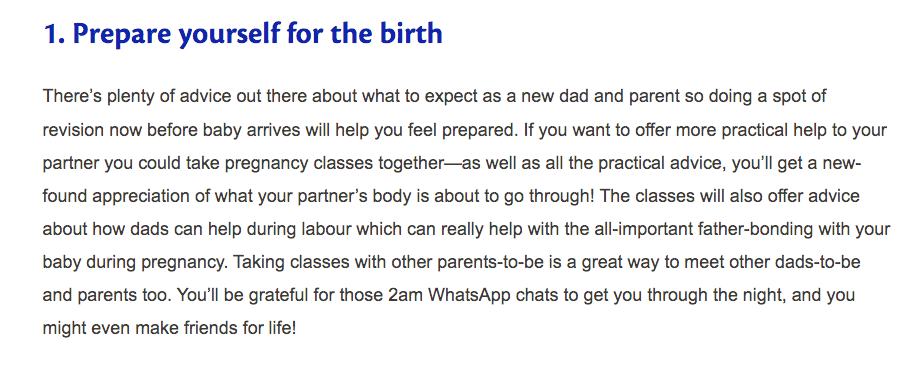
Notice how it’s a bit tough to read this?
It’s full of:
- Big words
- Long sentences
- Weak sentence structure
Plus it’s one giant paragraph.
It’s best to write in:
- Short sentences
- Short paragraphs
- Simple language
- Simple present with strong words
Limit usage of “can, will, be able to, and might be able to”. Instead, just use the simple present 3rd-person. So, instead of “it will offer” say “it offers”. And, instead of long sentences with lots of punctuation, split them into short sentences. There’s nothing wrong with starting a sentence with “and” or “but”.
Add as Much Helpful Information as Possible
Check this out.
Imagine you were a new dad trying to make a financial plan for your newborn. Is this helpful?

See how it’s very surface level? Yes, there’s a link to another article, but that article wasn’t very helpful either.
You need to think about what information will actually help the reader.
In this case, you could give:
- Practical tips for making a plan
- A financial plan template
- Apps to help save
- Cheap alternatives for common baby items
- Places to buy discount baby items like Goodwill
Things like that.
This is about both skill and effort. Most dad bloggers just want to fill the page and move along. Don’t be them. Outwork them.
When writing, always think “how can I help the reader more”.
When in doubt, add:
- Practical example
- Tips
- Clarification on complex topics
- Analogies and metaphors to help the reader understand better
- Your own personal experiences or that of others
Always go a level deeper and try to help the reader. That’s how you write great content.
Write Search-Engine Friendly Content
One more thing…
You also need to know basic SEO writing strategies if you want to rank on Google. Just don’t overdo it. Write for humans first and Google second.
Google even admits that SEO structure is super important in their guidelines, and they are usually full of disinformation and lies.
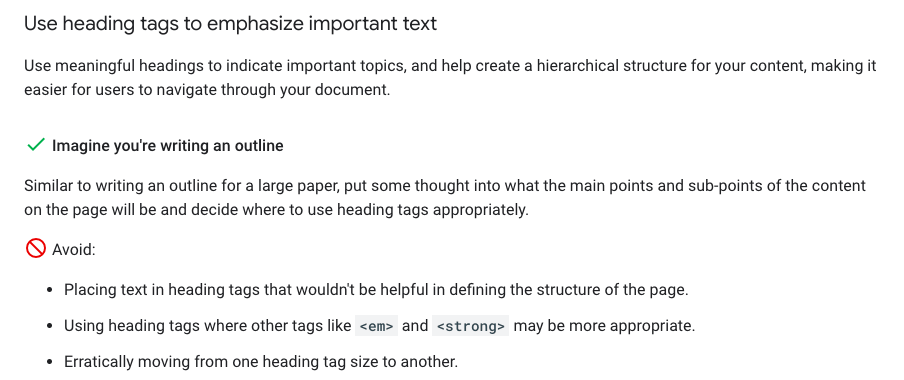
Just follow basic tips:
- Use lots of headings and subheadings like you see in this article. Chunk everything out into small, digestible chunks
- Use your main keywords in your headings, especially your main heading or title
- Write in short sentences and short paragraphs
- Use related keywords. You can find these in Ahrefs or on the search results page
- Link to other articles on your site within your content. Google loves this
Bonus: How to Monetize Your Dad Blog
Dad bloggers make money from their websites in a few ways. The most common are:
- Google Ads: You can run ads on your site once you have enough visitors. Apply for Google Adsense, and Google will display relevant ads to your visitors. They’ll pay you based on how many views or clicks your ads get.
- Affiliate Marketing: You can create transactional product review posts. These are usually “best” posts where you review products. If someone clicks the link and buys the product, you’ll get a commission.
- Your Own Products: The best dad bloggers create their own products like courses, eBooks, a newsletter, or even physical products. Once you have a brand, it’s possible to sell pretty much anything.
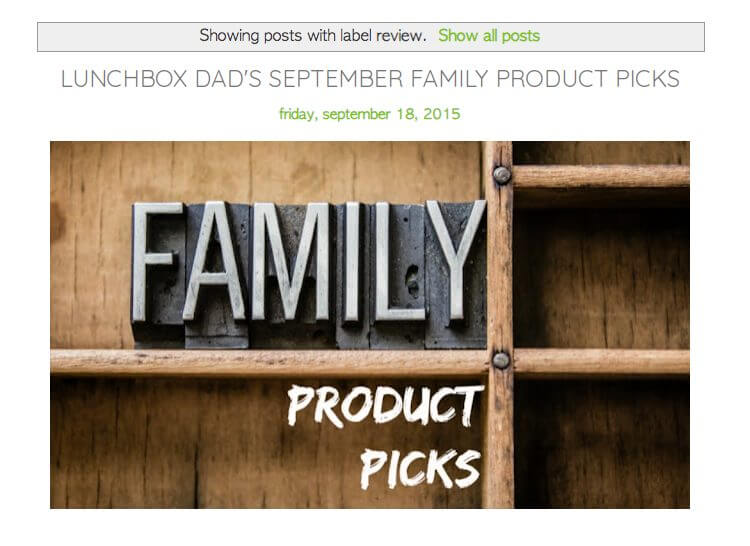
Here’s an example from LunchBox Dad showing easy affiliate marketing. He picks food-related products to review. If any of his readers buys the product, he gets a commission. Pretty easy, right?
The goal is to publish a lot of helpful content, get a lot of traffic, and grow a brand. Once you do, there are tons of ways to monetize your content.
Our Favorite Dad Blogs For Inspiration
The most successful people stand on the shoulders of giants. There’s no need to reinvent the wheel. The key to success with blogging is to see what others are doing, copy it, improve on it, and attack their weaknesses.
Check out these 3 top dad bloggers and follow their lead. Then, use the advice we’ve given you to become the most successful dad blogger in this space.
#1) Fathercraft
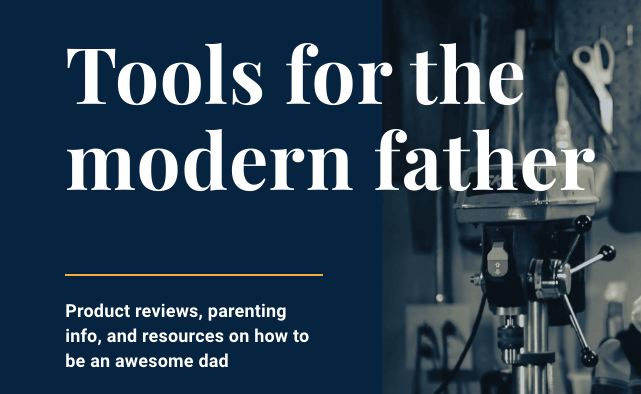
Why We Love Fathercraft
Fathercraft is a tour de force in dad blogging. Their story is perfect. Their marketing is spot on. And they’ve got a picture of a guy carrying a diaper bag for his daughter. Come on, man. What else do you want? Most other dad blogs don’t even come close.
Fathercraft is perfect for you if:
- You want the best products for dad’s with young kids
- You want to learn how to structure and market your own dad blog
- You want affordable courses teaching you essential dad stuff like how to care for your kids and how to prepare for fatherhood in a modern world
If you want to learn how to structure and market a dad blog, Fathercraft is the first blog you need to read.
#2) Fatherly

Why We Love Fatherly
Fatherly is the source for all things parenting advice.
It’s truly something special. Just from browsing the home page, you’ll learn:
- How to talk to young children
- How to recognize if you’re being a helicopter parent
- A simple a delicious taco recipe
- Exercises to control dad bod
- A ton of parenting humor
Use Fatherly as an example of how to produce great content. And definitely use it as a site to inspire to be like one day. Start in your niche and gradually expand to conquer the entire dad blogging space.
It covers all the bases of fatherhood blogging:
- Interesting life experiences
- Personal stories
- Parenting advice
- Advice related to newborns, toddlers, teens, and adults
- How to guides
- Family travel
- Insightful stories
- Insightful opinion pieces
It’s also got a great writing style. Definitely use this as an inspiration.
#3) LunchBox Dad

Why We Love LunchBox Dad
Lunchbox dad is one of the most inspirational father blogs for one reason: it shows how to dominate a niche and grow a brand.
It’s probably the best fatherhood blog for learning how to gain topical authority fast. It’s a little too niche for my taste. But they monetize it so well.
Here’s what they did:
- Create Linkable Assets: There’s a ton of “best recipe” articles. These are link magnets that help their rankings.
- Gain Topical Authority: Google sees this as a food authority and gives them better rankings.
- Grow a Brand: This is THE dad food blog. It’s got a great following.
- Monetize Food-Related Products: Once they gain that authority and trust, they create a ton of product reviews for cooking and start a newsletter.
This is a great blueprint to follow for your own blog. If you’ve got a lot of practical advice for other parents, you can monetize it in so many creative ways.
How to Start a Dad Blog: What’s Next?
You now know everything you need to start a profitable dad blog.
The only thing that’s left to do is start putting in the work. Take action now by figuring out your authority flywheel. What do you want to share with the world? What expertise do you have? What resources can you leverage?
Once you’ve found a sub-niche, write down your seed keywords and start researching. Once you get the ball rolling, you’ll never want to stop.
It’s easier now than ever before to make $5,000 – $10,000 per month OR MORE with your blog. Find your niche, find your low-competition topics, and get to writing. If you outwork other dad blogs, you’ll find success.
Good luck
How to Start a Dad Blog F.A.Q
Q: How Much do Dad Bloggers Make?
A: Dad Bloggers can make anywhere from $2,000 – $5,000 per month on average. Not quite as much as mommy bloggers. However, the best dad websites can make $5,000 – $10,000 per month or more. Being a daddy blogger is still a very lucrative opportunity.
Q: Are Dad Blogs Popular?
A: Yes, the best dad blogs are super popular. Blogs like Domestic Dad, Skint Dad, and Canadian Dad are incredibly popular and lucrative. Millions of people are interested in reading about your fatherhood journey if you have helpful advice to give. Another popular dad blog is Black Canadian Dad, which tells the parenting journey of being a minority father in Canada. If your blog focuses on providing help to fellow dads, you can build a popular blog too.
Q: What is a Daddy Blogger?
A: A daddy blogger is someone who writes about being a dad. It could be anything from “how to become a dad” to how to save money as a dad or even raising two kids as a single parent. The best dad blog right now is probably Fatherly. It’s a one stop shop for dad advice and products. There are millions of dads online writing about life advice for other dads. Jump on social media platforms and you’ll see who the most popular ones are.





